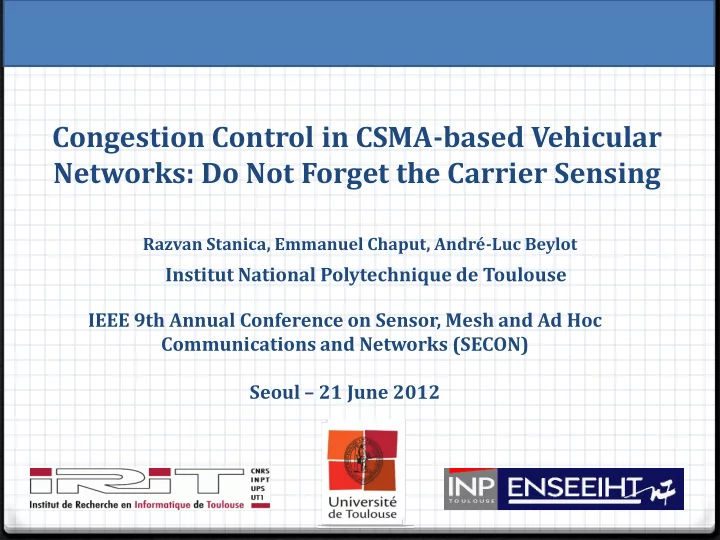

Congestion Control in CSMA-based Vehicular Networks: Do Not Forget the Carrier Sensing Razvan Stanica, Emmanuel Chaput, André-Luc Beylot Institut National Polytechnique de Toulouse IEEE 9th Annual Conference on Sensor, Mesh and Ad Hoc Communications and Networks (SECON) Seoul – 21 June 2012
Safety Communications in Vehicular Networks Types of Losses for Vehicular Beacons Safety Range CSMA Protocol Evaluation Conclusion & Future Work Razvan Stanica University of Toulouse SECON 2012 1 VANET Congestion Control: Do Not Forget the Carrier Sensing 21.06.2012
VANET objective: Building an accurate image of the exterior world Cooperative Awareness Message (CAM) Decentralised Environmental Notification (DEN) Safety V2V Types of Losses Safety Range CSMA Protocol Evaluation Razvan Stanica University of Toulouse SECON 2012 2 VANET Congestion Control: Do Not Forget the Carrier Sensing 21.06.2012
Safety Messages Cooperative Awareness Message (CAM) Periodic Position, speed, direction, steering angle ... ETSI TS 102 868 Decentralised Environmental Notification (DEN) Special events Hazard location, type, dissemination area ... ETSI TS 102 869 Safety V2V Types of Losses Safety Range CSMA Protocol Evaluation Razvan Stanica University of Toulouse SECON 2012 3 VANET Congestion Control: Do Not Forget the Carrier Sensing 21.06.2012
Safety beaconing Broadcast mode – no exposed terminals A beacon expires if the next CAM is produced Practically no internal contention on the CCH MAC delay automatically considered in the expiration probability Metrics of interest: reception probability, number of undetected neighbours Safety V2V Types of Losses Safety Range CSMA Protocol Evaluation Razvan Stanica University of Toulouse SECON 2012 4 VANET Congestion Control: Do Not Forget the Carrier Sensing 21.06.2012
IEEE 802.11p on the CCH 100% broadcast No ACK communication message Collisions can not be detected BEB mechanism Always use deactivated the minimum value for CW Safety V2V Types of Losses Safety Range CSMA Protocol Evaluation Razvan Stanica University of Toulouse SECON 2012 5 VANET Congestion Control: Do Not Forget the Carrier Sensing 21.06.2012
Congestion Control Beaconing Frequency Data Rate Transmission Power Contention Window Safety V2V Types of Losses Safety Range CSMA Protocol Evaluation Razvan Stanica University of Toulouse SECON 2012 6 VANET Congestion Control: Do Not Forget the Carrier Sensing 21.06.2012
Congestion Control Beaconing Frequency – problems in some scenarios (left turn assistant) Data Rate – questioned by field tests Transmission Power – included in SR-CSMA Contention Window – included in SR-CSMA Safety V2V Types of Losses Safety Range CSMA Protocol Evaluation Razvan Stanica University of Toulouse SECON 2012 6 VANET Congestion Control: Do Not Forget the Carrier Sensing 21.06.2012
Why are safety messages lost? Propagation Problems Expired Beacons Collisions Synchronized Transmissions • Hidden Nodes • Types of Losses Safety V2V Safety Range CSMA Protocol Evaluation Razvan Stanica University of Toulouse SECON 2012 7 VANET Congestion Control: Do Not Forget the Carrier Sensing 21.06.2012
Why are safety messages lost? Propagation Problems Expired Beacons Collisions Synchronized Transmissions • Hidden Nodes • Types of Losses Safety V2V Safety Range CSMA Protocol Evaluation Razvan Stanica University of Toulouse SECON 2012 7 VANET Congestion Control: Do Not Forget the Carrier Sensing 21.06.2012
Capture Effect Collision Capture Effect Types of Losses Safety V2V Safety Range CSMA Protocol Evaluation Razvan Stanica University of Toulouse SECON 2012 8 VANET Congestion Control: Do Not Forget the Carrier Sensing 21.06.2012
Capture Effect Collision Capture Effect Collision Types of Losses Safety V2V Safety Range CSMA Protocol Evaluation Razvan Stanica University of Toulouse SECON 2012 8 VANET Congestion Control: Do Not Forget the Carrier Sensing 21.06.2012
Safety Range CSMA More neighbours – longer back-off More neighbours – more expired beacons More neighbours – more collisions Safety Range CSMA Safety V2V Types of Losses Protocol Evaluation Razvan Stanica University of Toulouse SECON 2012 9 VANET Congestion Control: Do Not Forget the Carrier Sensing 21.06.2012
Safety Range CSMA More neighbours – longer back-off More neighbours – more expired beacons More neighbours – more collisions Collisions can not be avoided under high node density Safety Range CSMA Safety V2V Types of Losses Protocol Evaluation Razvan Stanica University of Toulouse SECON 2012 9 VANET Congestion Control: Do Not Forget the Carrier Sensing 21.06.2012
The New Access Method Safety Range CSMA Safety V2V Types of Losses Protocol Evaluation Razvan Stanica University of Toulouse SECON 2012 10 VANET Congestion Control: Do Not Forget the Carrier Sensing 21.06.2012
The New Access Method Idle channel – transmit (IEEE 802.11 approach) Safety Range CSMA Safety V2V Types of Losses Protocol Evaluation Razvan Stanica University of Toulouse SECON 2012 10 VANET Congestion Control: Do Not Forget the Carrier Sensing 21.06.2012
The New Access Method Another transmission detected – estimate the position of the transmitter Cross layer approach (PLCP – MAC) Safety Range CSMA Safety V2V Types of Losses Protocol Evaluation Razvan Stanica University of Toulouse SECON 2012 11 VANET Congestion Control: Do Not Forget the Carrier Sensing 21.06.2012
The New Access Method Collision Estimate if a collision could be solved by the capture effect inside the two safety ranges Safety Range CSMA Safety V2V Types of Losses Protocol Evaluation Razvan Stanica University of Toulouse SECON 2012 12 VANET Congestion Control: Do Not Forget the Carrier Sensing 21.06.2012
The New Access Method Safety Range Safety Range Collision One of the two safety zones is not safe, regardless of the used transmission power – back-off (IEEE 802.11 approach) Safety Range CSMA Safety V2V Types of Losses Protocol Evaluation Razvan Stanica University of Toulouse SECON 2012 13 VANET Congestion Control: Do Not Forget the Carrier Sensing 21.06.2012
The New Access Method Safety Range Safety Range Collision The safety zones are safe – transmit (using the highest transmission power that keeps them safe) Safety Range CSMA Safety V2V Types of Losses Protocol Evaluation Razvan Stanica University of Toulouse SECON 2012 14 VANET Congestion Control: Do Not Forget the Carrier Sensing 21.06.2012
If you can’t beat them, use them Possible Force Safety Estimation Collisions Range Errors Carrier Sense Range Safety Range CSMA Safety V2V Types of Losses Protocol Evaluation Razvan Stanica University of Toulouse SECON 2012 15 VANET Congestion Control: Do Not Forget the Carrier Sensing 21.06.2012
Recommend
More recommend